|

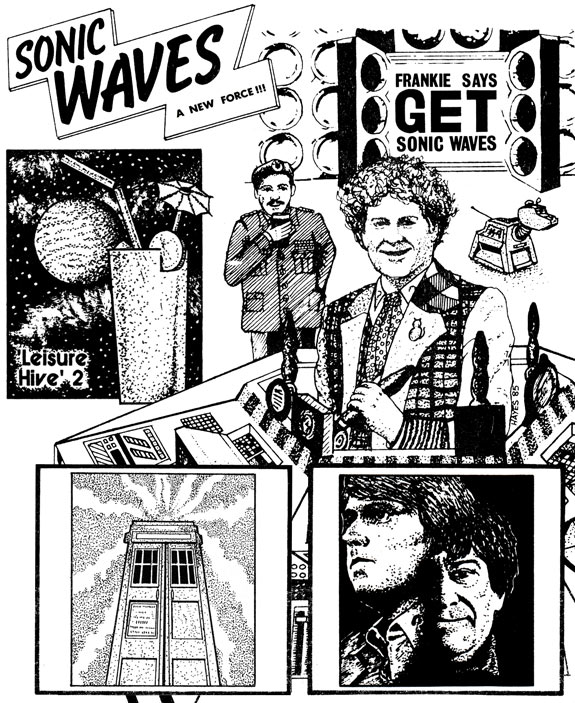
Image © Alan Hayes, 2024
|
The Basics |
|
Place of Origin:
Plumstead, London, UK
Editors:
Alan Hayes (all) and Paul Hewson (#1 only)
In
Production:
1984-87, 2000-01 |
Distribution Media:
Audio Cassette / Compact Disc
Tape Lengths:
#1-5, Media Magazine: C-90; #6: C-90 x 2
Special Editions: CD74, CD80
Issues Produced:
7 (+ 6 Special Editions) |

As students at
Woolwich Polytechnic Boys’ School in South East London, Paul Hewson and
Alan Hayes were brought together through their shared interest in
Doctor Who and cult TV. “Although Paul was a couple of years younger
than me,” recalls Alan Hayes, “we were both preparing to leave school –
Paul from the Fifth Year and me from the Upper Sixth – and the idea for
what ultimately became Sonic Waves came to us at this time. We’d
seen a small number of tapezines advertised in Celestial Toyroom,
and that fired the idea, really. In a kind of fact finding mission over
the next few months, we picked up a few issues of
Zero Room Audiozine,
UNIT Tapezine,
The Logopolitan and
CVE Tapezine to get an idea
of what producing a tapezine might entail, and how we might go about
planning our first issue. We considered that, while each of these titles
had plenty going for them and certainly entertained us, we’d be able to
produce something that was of equal quality and perhaps a little
different. We weren’t over-confident, but we did think that we’d be able
to compete from the off.”
There was a
definite advantage in the fact that there were still relatively few
tapezines available, despite the sudden boom in the numbers being
produced. “If instead we had wanted to start up a new printed fanzine,
we would have faced strong competition from the large number of
well-established print fanzines available; the pages of Celestial
Toyroom were positively flooded with adverts for them, each and every
month,” Alan notes.
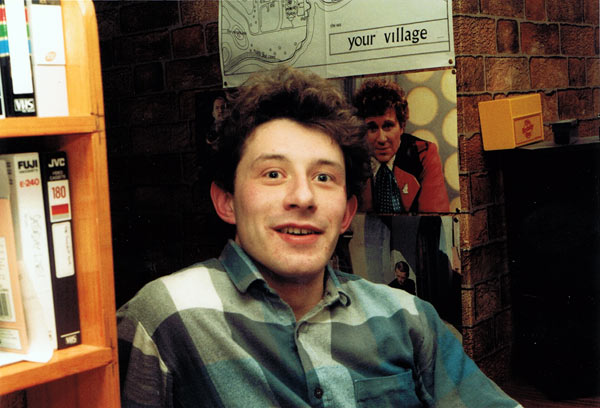
Editor Alan Hayes in the Sonic Waves 'studio'
Image © Alan Hayes, March 1986
Alan had
previously edited two printed fanzines, one at 14 called Fury from
the Deep, a “road accident of a fanzine” as he now describes it,
plus two early issues of Shada, where he briefly inherited the
editorship from Gary Russell. “I felt a bit out of my depth with
Shada,” Alan admits today. “Fortunately, Gary came back on board and
quickly shook things up and before long, Shada was deservedly
doing well in DWAS Fanzine Polls. My perception was, until recently,
that Gary had realised just how standards had dropped under my control,
and stepped back in, dealing with the situation kindly and in an
entirely gentlemanly manner. This, indeed, he did, but only recently I
discovered from him that I’d been asked to edit the fanzine during a
period where he would not be available to do so himself, so the plan was
always that he would return. This was pleasant to hear, but at the time,
I think I realised that I wasn’t sufficiently mature, knowledgeable or
confident as a writer.”
By the time of
Sonic Waves, Alan had also written for many fanzines including
Inner Sanctum, Dynatrope, Steel Sky, Tara and
Peladon and produced the Doctor Who Cassette Cover Project,
which consisted of black-and-white line art cassette covers that he and
several like-minded Doctor Who fans had drawn as they simply couldn’t
bear their TV soundtrack cassettes to be wrapped in plain covers. This
latter endeavour fed into the cover designs of Sonic Waves, with
Alan designing them all, although some were less successful than others
– Daleks doing impressions of the Leaning Tower of Pisa, anyone? At
least he didn’t miss a trick with the third issue, the cover of which
proclaimed “Alexei Who?” beneath a drawing that looked almost entirely
unlike its subject, the actor and comedian Alexei Sayle. “I remember the
drawing coming out so poorly,” reflects Hayes, “that I sneakily added
the wording in the hope that it might subliminally make the purchaser
overlook the quite pathetic resemblance to Mr. Sayle!”
Meanwhile, Paul
Hewson brought his natural cocky showmanship to the party and his
experience of acting in the Greenwich Young People’s Theatre (GYPT)
stood him in good stead for presentation, readings and dramatic content.
In planning their
first tape, Alan and Paul agreed that a vital consideration should be
sound quality, which should be as good as possible. “One of the things
we’d noted with the tapezines we sampled was that good material could
often be spoiled by the technical quality of the recordings,” remembers
Alan. “By the time we came to record, I had been on a day-release audio
visual training course for a year and so I probably had a bit of an
advantage in this area. However, the professional equipment I was using
at work and on the course was not available to me, so Paul and I had to
improvise with what we had and buy, as affordably as possible, what we
didn’t.”
Unfortunately,
this commitment to sound quality proved to be something of a
double-edged sword, as after they had recorded over half an hour’s worth
of material for the first issue (at that point called Sonic Force),
the pair chanced upon a better recording method and together decided to
re-record everything from scratch. Initially, recordings were made by
speaking into an open microphone as backing music was played in live
from a record deck. “Then I stumbled across a really cool, unexpected
facility that my Sharp QT89 double-tape ‘ghetto blaster’ deck had,” Alan
remembers. “Whereas most decks of this type would only allow you to play
a cassette on one deck and record on the other, this one would do that,
but it would also allow me to play cassettes in both decks
simultaneously and I could record the combined output to an external
recorder via the Line Out jacks. This meant I could pre-record the music
onto one cassette, lowering the recording level at a pre-determined
point so that I could later combine it with the speech, which I would
record separately. As the speech could now be recorded without playing
music in live, it meant that I could edit any fluffs out, too (and there
were plenty!). When creating the mixed master, I’d have the speech tape
cued up, play the music tape and release the pause to start the speech
playing at the appropriate point. Thinking back, this was a terribly
involved process, but it allowed me to effectively multi-track on the
cheap and worked surprisingly well.”
During this
period, Sonic Force was renamed Sonic Waves and Paul
started to become disenchanted with the project, finding it considerably
more long-winded, time-consuming and demanding than he had at first
anticipated. For this reason, Paul walked away from Sonic Waves
about halfway through the recording of Issue 1. Without a doubt, the
forced re-record for quality reasons contributed to Paul’s departure, as
Alan reveals: “Boredom set in and, in all honesty, Paul had a creative,
imaginative spirit about him and I don't think that doing things over
and over really was really him. He also wasn’t as single-minded
about Doctor Who as I was at the time, and he quickly found other
things with which to fill his time – his amateur dramatics, punk rock
and Adam and the Ants, and more besides. Maybe he was expecting wild
parties, booze and excitement from Sonic Waves? No such luck!
However, the decision to re-record definitely caused something of a
flashpoint, and sadly, our friendship dissipated rapidly and didn’t get
back on track until Facebook came along. Sad, really. He was always
great fun to be around – he shines brightly.”
Now the sole
editor of Sonic Waves, Alan Hayes slowly built a team of regular
contributors from all over the United Kingdom. “Fortunately, my main
collaborators, Jim Mortimore and, later, Jean Riddler, were very local
to me and invaluable to the project and, even more so, to my sanity,”
Alan says.
Right from the
start, Sonic Waves boasted a healthy mix of contributors including
Robert Franks, co-editor of the well-regarded printed fanzine Dynatrope,
Darren Field and Darren Sevket (another Plumstead local). Despite it
being a first issue, the editors also managed to rustle up a letters
section consisting of contributions from Richard Clarke, David Hamilton
(no, not that one) and Matthew Sweet (yes, that one!). This was helped
in no small amount by Alan taking out advertising space in the September
1984 edition of the DWAS
newsletter Celestial Toyroom, some three months prior to the
first issue's publication. The advert advised that DWAS members watch
out for Sonic Waves, promising it that would not be "just another
audio tape magazine - we think it's going to be something rather
special," before asking for articles and audio letters of a high
technical quality. Hiss would not be entertained...
Sonic Waves always
ran instrumental music tracks to accompany features. Many of these were original
compositions produced by Jim Mortimore, including two new arrangements
of the Doctor Who theme which were heard at the beginning and end of
each issue (the first used for issues 1-3 and the second for 4 and 6)
and the Sonic Waves Mediatheme, for the Sonic Waves Media Magazine in
1987. Jim also created atmospheric pieces which were used to link items,
running underneath continuity announcements. Jim occasionally worked in
tandem with Owen Parker on these pieces and the pair also scored short
dramatic works for Sonic Waves. These pieces were recorded using a
Tascam 244 four-track portastudio recorder and employed synthesisers,
effects units and drum machines. Jim Mortimore remembers this as being
his way of pushing the editor towards more complex editing techniques:
“Writing music, editing shamelessly stolen pre-existing music and making
teeny-weeny-mini-adventures on portastudio were my only hope in a cold
and lonely universe of convincing Alan that he was wrong, wrong and
thrice-damned wrong, that the whole project should have been done on
multitrack right from the off, and why the hell didn’t he just do as he
was told anyhow? Alan, being Alan, listened politely and carefully to
everything I said and then did exactly what he wanted anyway. And
naturally enough, the product suffered not in the slightest.”
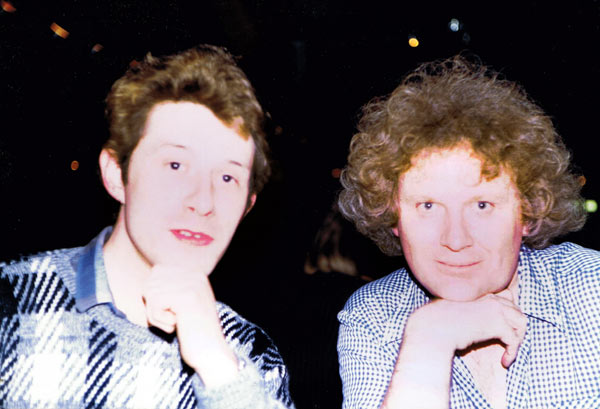
Meeting Colin Baker at The Beck Theatre in December
1986
Image © Alan Hayes, 1986
One of the absolute scoops for Sonic Waves was A Letter from the Doctor,
which debuted in Issue 1 and became a regular feature. Alan Hayes takes
up the story. “Just after Paul left the project, an idea struck me –
what if I sent blank cassettes with return envelopes to a variety of
Doctor Who cast and crew members? Perhaps they might record a message
for the listeners or a greeting that I could turn into a jingle? I duly
sent off some cassettes via the Doctor Who Production Office in
Shepherd's Bush, not really believing that any would find their way
back to me. Just days later, a packet arrived on the mat at my home,
containing a cassette that I had sent to the then current Doctor, Colin
Baker. Initially, I imagined it had simply been returned blank, but as
soon as I played the tape, my heart skipped a beat. Colin had not only
recorded a message for Sonic Waves listeners, he had also recorded a
lovely personal message to me, wishing me the best of luck with the
project and saying that he would be happy to record further messages for
Sonic Waves. He was as good as his word and, over the space of two
years, recorded a series of wonderful messages especially for my humble
little endeavour. He would discuss what he was currently working on, his
thoughts on the stories that had been broadcast, and his plans for the
future. He even recorded one message in his dressing room prior to going
on set to record his last scene as the Doctor (not that he was aware of
this at the time). I feel immensely indebted to Colin
for his exceptionally generous and enthusiastic help with Sonic Waves.
Such a kind and warm-hearted man.” Other tapes sent out that were
returned recorded came back later from Cyberman actor David Banks and
visual effects maestro Mat Irvine, who even recorded himself giving
listeners a “Sonic Wave”!
Another regular inclusion in Sonic Waves was the Trivia Section, which
offered novelty items such as soundtracks of television trailers from
around the world for Doctor Who stories, commercials related to the
series, vintage news and other programme items, such as the announcement
of the death of William Hartnell from 1975 and Tom Baker’s appearance on
Animal Magic from 1979. These proved to be among of the most popular
inclusions on the cassettes, which Alan remembers as being “mildly
irritating considering the hard work that had gone into everything
else!”
Large parts of
Issues 1 and 2 were given over to guest panel soundtracks recorded by
Daniel Cohen at the BBC’s 1983 Longleat Doctor Who Celebration
(coincidentally, an early Zero Room also featured material from this
event, from an alternative recording source). These featured the
reminiscences and anecdotes of actors including Jon Pertwee, Peter
Davison, Nicholas Courtney, Janet Fielding, Mark Strickson and Sarah
Sutton. “While these recordings were undoubtedly of interest to many
listeners,” Alan Hayes comments, “I soon realised that such items were a
bloody lazy way to fill a tapezine and as a result I sought to
commission as much original content for subsequent issues as I possibly
could. On reflection, this was the right decision, not least because
looking back, I now see that many other audiozines were using similar
recordings at around the same time, something I had not then been
greatly aware of. If fans were buying a selection of tapezines, they
were probably having regular feelings of déjà vu.”
Advertised in the
December 1984 Celestial Toyroom, Sonic Waves Issue 1 was
actually unleashed a few weeks earlier, with contributors receiving
their copies in
November. Five months passed before the publication of the second
issue and Doctor Who’s fortunes at the BBC took a major nosedive during
this time. This led to the editor rounding off Issue 2 with an angry
rant about the BBC’s cancellation of Doctor Who which somewhat
overshadowed the otherwise very decent content such as a short dramatic piece, dripping
with atmosphere, which was ironically entitled Crisis Point.
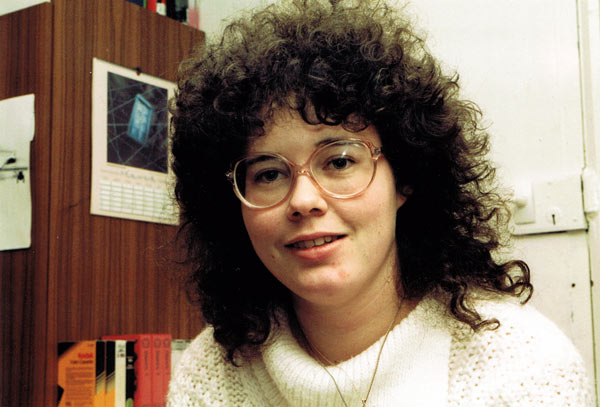
The effervescent Jean Riddler at a Sonic Waves
recording
Image © Alan Hayes, March 1986
Important
additions to the Sonic Waves writing team in this issue were Jim
Mortimore, a next-door-but-one-neighbour, who had previously helped with music and would later write
official Doctor Who fiction for Virgin, BBC Books and Big Finish, and
Jean Riddler, a fan with a bright and bouncy personality who today is
part of the hugely successful
Staggering Stories
podcast team.
The third issue of
Sonic Waves was released three months later in May 1985 and was entirely
set aside for reviewing aspects of Season 22, which had just been
transmitted. As such, it was the first of two special issues of Sonic
Waves, the other being Issue 5. Yet more writers joined the fray,
including Tim Ryan, Steve Watts, Robert Cook (another Dynaptrope
co-editor and neighbour of Robert Franks) and Trevor Phillippo.
Tragically, Trevor would die of a brain haemorrhage less than two years
later in February 1987, aged just 25. “When I learned of Trevor’s
passing, I regretted having been such a stickler for recording
standards, as I had insisted on him taping his The Mark of the Rani
review three times over, sending it back to him the first two times. He
had the patience of a saint. A lovely, gentle chap,” Alan comments.
The Sonic Waves
3 reviews came
thick and fast, with the whole season discussed in minute detail over an
hour and a half, with time still allowed for Colin Baker’s A Letter from the
Doctor along the way, in which he reflected upon the season and
commented on the disappointment he felt at the suspension of production
on the following series of Doctor Who.
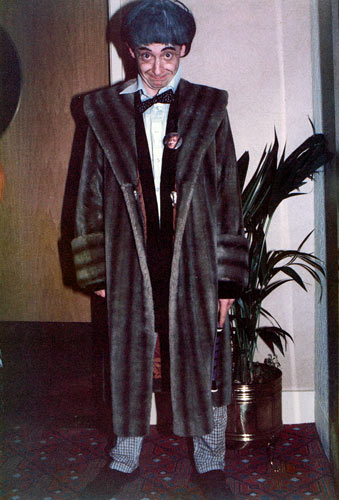
Adam Vanger, brilliantly comical as Sonic Waves'
Second Doctor,
turned up in costume at the 1986 Leisure Hive convention
Image © Alan Hayes, 1986
“Midway through
the tapezine’s run, Daniel Cohen – whom I had met through Jim Mortimore,
the pair playing together in a New Romantic band, Utopian Dream – approached me with
an idea and offered me the chance to include original comedy sketches in
Sonic Waves,” Alan remembers. “Right from the start, I had been
keen to keep listeners on their toes, hopefully unable to predict what
the tapezine would deliver, and to my mind, this was ideal and would
also address the concerns I had that Sonic Waves was perhaps a little
too straight-laced.” The sketches – which began in Sonic Waves Issue 4
with Doctors in Distress (a spoof on Ian Levine’s charity single
designed to ‘save Doctor Who’) on Side 1 and The Doctors’ Schooldays on
Side 2 – proved very popular with most listeners, although a few
complained that the comedy was not to their tastes. The team
comprised Daniel, Adam Vanger and Steve Watts, and their skits would
feature in all subsequent Sonic Waves issues, even the Media Magazine,
in which they commenced the ultimately never-completed series
documenting the adventures of Highness Royale, a Chandleresque 'private
dick' who sounded suspiciously
like the then Prince (now King), Charles – Mission to Magma.
January 1986 saw
the publication of Sonic Waves 5, dubbed ‘The Leisure Hive II Special’,
a joint venture with the committee of the Leisure Hive conventions and
planned in early 1985. Sonic Waves was given exclusive rights to present
edited soundtracks of the guest panels at the Leisure Hive II convention
to be held in Swindon, Wiltshire, over the August Bank Holiday weekend
of 1985. This was clearly too good an opportunity to miss, but
unfortunately for the editor, Alan Hayes, he would indeed miss it due to
a combination of terminal shyness and the daunting prospect of starting
his first proper job on the Tuesday after the convention. All was not lost, however. “The wonderful Jean Riddler
kindly volunteered to be Sonic Waves’ roving reporter in Swindon,” Alan
explains. “She took a portable recorder to the convention and did a
tremendous job interviewing cast, attendees and organisers alike, her
natural effervescence bringing everything she recorded wonderfully to life.
Frankly, she did a far better job than I would ever have done – she was
quite brilliant. It is impossible not to like Jean and therefore people
were delighted to have her microphone thrust under their noses!”
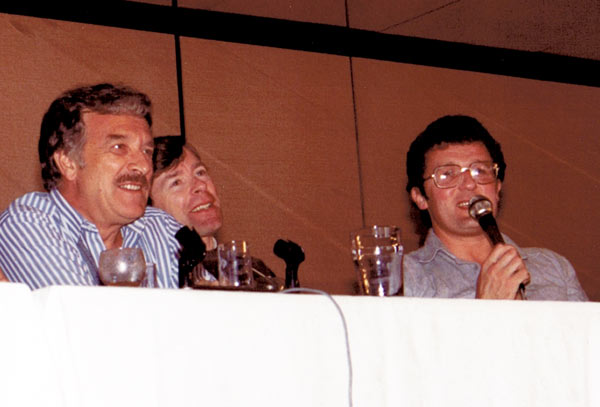
Nicholas Courtney, John Leeson and Ian Marter
were among the guests at Leisure Hive II
Image © Alys Hayes, 1985
Listener Keith
Musselwhite was surprised when he realised that his Leisure Hive II
exploits had come to the roving reporter’s attention: “When I first met
her, Jean thought I was weird because I could quote huge chunks of her
Sonic Waves articles. She referred to me twice on Sonic Waves
5 without
naming me. Firstly, I was the person that started the Five Doctors
quote-a-long and was going ‘Vworp vworp!’ in the video room on the
Friday night of the convention. I was also the person she mentioned as
saying that John Levene’s singing had improved since Recall UNIT!
Along with three of my questions making it onto the guest panels on
Sonic Waves 5, I have many reasons to be especially fond of that issue.”
The recordings of
guest panels were edited from video recordings made by the organisers.
This issue was being worked on concurrently with Issue 4, but was
advertised and released three months afterwards.
After the release
of Sonic Waves 5, with work and social commitments limiting the time
available to work on Sonic Waves, and a growing concern that before long
the audiozine would be repeating itself in terms of content, Alan
decided that perhaps the time had come to wind it down. “I was still
very much in love with Doctor Who, but I was beginning to find Sonic
Waves more work than play, due in large part to the increasing amounts
of time I was having to spend duplicating listeners’ copies. Much as I
enjoyed producing Sonic Waves, I thought I’d done pretty much all I
could with it and so I took the decision to bring it to an end. However,
I was determined to go out with a bang.” This was achieved by producing
an unprecedented double issue lasting three hours, over the course of
which there were occasional doom-laden interruptions from a particularly
throaty Vogon (from Douglas Adams’ The Hitchhiker’s Guide to the Galaxy
– in reality, the editor), issuing warnings of the imminent
destruction of Sonic Waves. Out to save the audiozine from the Vogons
were Messrs. Cohen, Vanger and Watts’ comedic and argumentative Doctors,
a rescue which was always doomed to abject failure.
Sonic Waves 6
contained the usual mix of features, only in far greater abundance than
usual, with submissions from regulars like Matthew Sweet and Tim Ryan,
and newcomers such as Alan Barnes (later of Doctor Who Magazine and Big
Finish), Martin Holder and Nicholas Briggs (now BBC Dalek and monster
voice extraordinaire and Big Finish Producer), plus a special feature
contributed by Cyberman actor-turned-author David Banks and an
entertaining interview with the BBC Visual Effects wizard Mat Irvine.
Issue 6 was
advertised in Celestial Toyroom with a fake newspaper report speculating
upon the demise of Sonic Waves. Content ranged from reviews of Doctor
Who and the Silurians and Enlightenment and comedy from Daniel, Adam and
Steve, to Home or Away – a dramatic reading by Jean Riddler – and informal
looks at the The Who Shop, the Blackpool Doctor Who Exhibition and an
account by the editor of a day on set during the recording of The Trial
of a Time Lord at Television Centre. [Thanks for sneaking me in, Anthony. Miss you,
chum. Ed.]
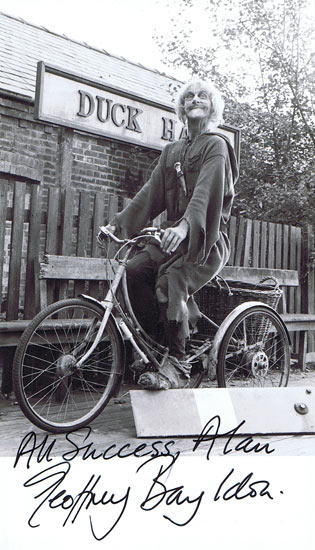
London Weekend Television publicity card signed by
Geoffrey Bayldon
Image © Alan Hayes, 1986
By the time the recording
process on Issue 6 was nearing completion, Alan changed his mind about a
complete shutdown, thinking that there was perhaps still life in
Sonic Waves. However, to keep it interesting for himself and the
listeners, he decided to relaunch it as something quite different. When
Sonic Waves rose from the ashes of that Vogon attack in March
1987, it was as Sonic Waves Media Magazine 1. The tapezine still
featured Doctor Who to a minor degree, but widened its remit to
cover television in general. Series under the microscope
included The Omega Factor, Target, Phoenix Five,
Supernatural and The New Avengers, and the writing team
expanded to include telly experts Matthew Morgenstern and Shaun Brennan. With no slight
intended to those esteemed contributors, the undeniable highlight of the issue was an
extensive interview with Catweazle star Geoffrey Bayldon which
was conducted at his home in Barnes, South West London.
The issue sold
significantly less well than previous issues, its sales stalling in the
high forties. This relatively poor showing was perhaps predictable as
the editor elected not to advertise Sonic Waves Media Magazine
beyond the pages of Celestial Toyroom. “If you dig out and dust
down your mid-1980s CTs,” says Alan, “you’ll see adverts for a
plethora of fanzines, the vast majority of which, quite unsurprisingly
of course, feature Doctor Who from cover to cover. Occasionally,
you’ll notice the occasional publication that drops an article or two
into the mix concerning The Prisoner, Blake’s 7 or The Hitchhiker’s
Guide to the Galaxy, but aside from the trailblazing and excellent
Time Screen and the short-lived Tara and Shadow Play
fanzines, which explored television more broadly, there wasn’t a
sufficiently established market within the DWAS at that time for the new
Sonic Waves to tap into.” Despite an interview with actress
Annette Andre of Randall and Hopkirk (Deceased) having been
recorded in June 1987 for a second Media Magazine issue, the
follow-up was
ultimately abandoned and Sonic Waves disappeared without fanfare.
In its time, Sonic Waves
achieved a high ranking of 19th in the DWAS Fanzine Poll of 1984, had a
team of highly talented contributors, many of whom have since gone on to
far greater things, and is known to have inspired
at least three subsequent tapezine producers, Nick Goodman (Rayphase
Shift), Keith Musselwhite (Meglos,
Death Zone and
DZFM)
and Andrew Wink (The SFOW Express).
By the end of the run, with
late adopters catching up via the Sonic Waves back issues
service, each issue bar the Media Magazine had reached an
audience in excess of a hundred listeners. In common with the way in
which most tapezines were made and distributed, Sonic Waves was
duplicated using the same equipment employed to originate the tapezine
itself as Alan explains. “I had the facilities to copy cassettes at
double speed, so it would ordinarily take me 45 minutes to run off a
single copy of a 90-minute issue of Sonic Waves. However, after a few issues, I
found the gaps between new issues would keep expanding because of the
amount of copying I was having to do; people were asking for copies of
the latest issue and often also the ones that preceded it. In some ways,
it would have made sense to go down the path of professional
duplication, but I soon realised that doing so would contravene the
terms and conditions imposed upon audio fanzine producers by the BBC,
who insisted that purchasers had to supply their own blank cassettes.
Meanwhile, I couldn’t originate new material because the cassette deck
was whirring away making copies. On reflection, the number of orders I
had was just about manageable with the copying equipment and time I had
available. In some ways, I was grateful that Sonic Waves’ success
was relatively modest as I’m sure I would have suffered a nervous
breakdown trying to fulfil a significantly larger stream of orders! The
BBC guidelines were cunningly crafted to ensure that any tapezines that
attracted high order volumes would find themselves faced with
impractical constraints on the duplication process. While tapezine
producers like myself were grateful for the blind eye the BBC turned
towards us as we played fast and loose with their copyrights (not that
profit was ever a motive), these
guidelines undoubtedly hastened the demise of many a tapezine and Sonic
Waves may well have survived for a while longer with a kinder set of
rules to follow.”
“Looking back on Sonic
Waves, there were good bits, bad bits and some completely embarrassing
bits,” Alan comments, “but overall, I’m still proud to this day with
what was achieved with, for the most part, very basic equipment in a
small, practically triangular bedroom at the parental seat on Shooters Hill. If only I could have
got rid of the annoying short wave radio interference from the
transmitter up the road, although at least that did perhaps distract
from my often awkward delivery style! Listening to the tapes today, I
can hear my voice hovering between pubescent insecurity and plain terror
for most of the time. I was a shy kid, lacking in confidence anywhere
other than on the football pitch (yes, a sporty Doctor Who fan!), and yet I kept plonking myself in
front of microphones, reading tongue-tied from the badly worded scripts
I’d written, as if daring myself not to be a shrinking violet. I was no
disc jockey and I knew it, but at least I tried. And I’m glad I did, as
those four years hold so many happy memories: the laughs I had with Paul
in those early days; spending many carefree hours with Jim as he worked
on music for the tapes and never once complained about my complete lack
of musical ability or insight; hearing each of Daniel, Adam and Steve’s
comedy sketches for the first time; receiving regular audio messages
from Colin Baker, the Sixth Doctor, and telling my parents that ‘this
tape has come from Doctor Who!’; ‘discovering’ broadcaster Matthew
Sweet, whose wickedly funny and brilliantly observed features for Sonic
Waves marked him out to me as someone with real talent (though the idea
I discovered him is completely ridiculous, of course!); and having a
whale of a time with the delightful Jean Riddler, recording her
wonderfully idiosyncratic articles and just enjoying her joyous
company.”
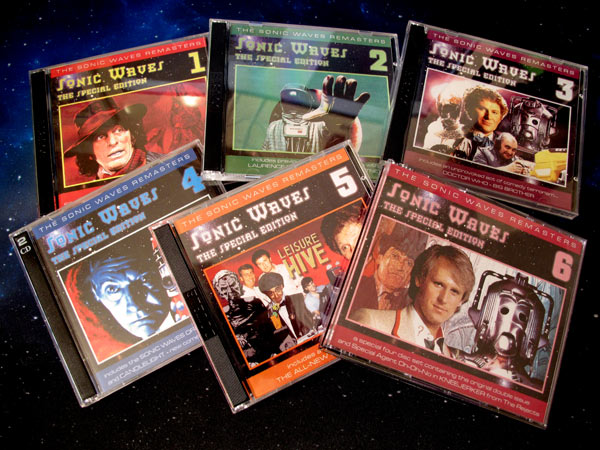
Thirteen years after Sonic Waves ended, there
was a twist to the tape!
Image © Alan Hayes, 2024
Many years later, Sonic
Waves had an unexpected, small-scale revival when a group of mainly
Salisbury-based Doctor Who fans got into a conversation with its
editor
on the now long defunct Doctor Who Technical Forum, having asked
the rather odd question, “Are you the Alan Hayes?” It turned out that
they were ardent Sonic Waves fans and "Contact had been made",
though space viruses were not exchanged. This inspired Alan to digitise his
master recordings of Sonic
Waves and the Sonic Force pilot,
archive them to CD-R discs, and make copies for these new friends. While
compiling the discs, he decided to utilise several interviews he had
conducted since the time of Sonic Waves as bonus features.
Consequently, the soundtracks of video interviews with actors Laurence
Payne, Nicholas Courtney, John Levene and Nabil Shaban were also
digitised and featured on each Sonic Waves Special Edition. It
was not long before Alan was producing new material for these CDs,
including comedy skits
by The Rejects, a group comprising Alan, his wife Alys, David Atkins,
Jane Atkins, David Hamilton, Martin Holder and original Sonic Waves
funster Steve Watts. Each of these was based on a particular film or
television series, given a Doctor Who twist, for instance
Kneejerker, a James Bond / Doctor Who spoof, or Big Brother, where the
classic Doctors are all contestants in the Big Brother House. Arguably
the most successful of these skits – artistically, for The Rejects
were convinced no one ever listened to the skits! – was Where Are You
From Exactly?, an improvised skit in which Steve and Alan mercifully
lampooned the bizarre accent employed by Lewis Fiander as Professor
Tryst in Nightmare of Eden.
In February 2012, nearly a
quarter of a century after Sonic Waves had closed its doors, Alan
unearthed his master tapes for a second time, spruced them up with
modern software and reissued them in MP3 Audio format on a data DVD
under the moniker Sonic Waves: The Official Digital Edition. The
collection contained all seven issues along with a series of bonus
interviews recorded for audio and video projects in the late 1980s. Also
offered on the disc were ten incidental tracks forming Sonic Waves: The
Original Soundtrack and a series of PDF files documenting the history of
Sonic Waves, a full contents listing and scans of the original
cassette covers and advertisements.
“The timing seemed perfect,
what with Doctor Who’s fiftieth anniversary then being imminent,” says
Alan. “Fans were looking to the past as well as the future and with the
passing of three decades, Sonic Waves had unwittingly become a
fascinating peepshow into fandom’s past. It captures the voices and
opinions of a wide range of commentators and hails from a distant,
exciting, but somehow more innocent era of Doctor Who fandom, which is
quite different from today’s incarnation.”

Without a doubt, the most memorable feature of Sonic Waves is the
editor’s deathly outburst about the cancellation of Doctor Who, to be
heard – or better, avoided – at the end of the second issue. It’s
memorable for the wrong reasons… The anger, disbelief and outright
indignation can be heard in Alan Hayes’ voice right from the start where
he notes that the listener “will have noticed by now the lack of music.
Frankly, the following doesn’t lend itself to such treatment. The reason
for such action is no doubt obvious. Today, February 27th, the BBC
announced the suspension of Doctor Who.” It’s as if a monarch or other
respected public figure had died, but perhaps he was taking his lead
from the end credits of Part 4 of Earthshock. He continued, “It goes
without saying how sad, cheated and angered I feel at this ludicrous and
pointless betrayal, a betrayal of us the fans, not to mention the
public, the world, but most of all an undoubted kick in the vitals for
Colin Baker. The equivalent of three months’ screen time and he’s as
good as rejected, cheated, his good intentions, enthusiasm and his
energy all betrayed… The BBC is cutting its own throat – they used to
have respect for their productions. Over the last few hours, that has
obviously vanished.” At this point, it becomes clear that Alan had
already telephoned friends and had become convinced of the various
conspiracy theories that were circling and offers listeners “the truth”.
John Nathan-Turner not returning? Tick. Colin Baker and Nicola Bryant
quitting in disgust? Tick. Eighteen months a lie? Tick. Alan then
suggested listeners write to the BBC, the national press and various fan
bodies, recommending that, “if you can write ten letters under
pseudonyms, do it! Do anything you can… Save Doctor Who!”
“It’s a deeply embarrassing diatribe,” admits Alan sheepishly today, “but it
does in some way capture the shock and exasperation felt by Doctor Who
fans at the time of the 1985-1986 hiatus, recorded as it was on the day
that the announcement had been made on BBC News. Everyone I spoke to in
fandom around that time was bewildered, angry and disbelieving – Doctor
Who was an irreplaceable part of our young lives and the BBC’s decision
to cancel it was, to us, indefensible, unprecedented. With my emotions
running high, I realised that in Sonic Waves I had the perfect,
ready-made soapbox – a microphone, a cassette recorder and an audiozine
just about to be distributed. I should really have taken a breath and
reconsidered, as I’ve been living it down ever since! Despite this, it
is in some ways incredibly funny without meaning to be. Thank goodness I
can laugh at myself!”

Commenting in The Tapezine
Zone section of Zero Room Issue 7 (April 1985), David Balston appeared
fairly happy with the first two issues: “Sonic Waves has the most
amazing rendition of the Doctor Who theme, by James Mortimore. They also
have a nice little message from Colin Baker in the letters section,
which contained people reading their own letters on tape. The original
aspect of this ’zine was the Trivia Section, which played such things as
the Web of Fear trailer where Patrick Troughton talks to the viewers,
and various other trailers, the Keep Australia Beautiful advertisements,
and the unused Doctor Who theme, first heard on Zero Room 4.
Sonic Waves
2 is also extremely good, and is probably the first ’zine to comment on
Michael Grade’s ludicrous 18-month suspension [of] Doctor Who. ”
Death Zone Issue 2
(August 1989) included a brief review of Sonic Waves, with Keith
Musselwhite looking back to the early days of tapezines: “[After the
first few tapezines were issued,] then came the biggie, in the form of
Sonic Waves, which started in November 1984. Sonic Waves was perhaps the
big turning point in the style of tapezine production. It was so
professionally produced that you would have thought it had been produced
by a professional fan or group of fans. In fact, its standard has yet to
be matched in either quality, quantity or sound control. I wish I had
your machine, Alan Hayes, what I wouldn’t do for it!”
Some considerable time after
Sonic Waves had ceased publication, it received an unexpected review in
Spotlight (Issue 15, April
1996) and even took to the cassette cover for what proved to be the
final edition of this tapezine. Editor Elaine Bull remarked, “Well-known
among a certain group of elite listeners is the Doctor Who tapezine, now
deceased but not forgotten, Sonic Waves. To its credit it
produced six issues of mostly interesting listening and [featured] a
rather addictive group of chaps, with their own sense of daft humour
based around Doctor Who. They performed a four-part saga called
The Doctors’ Schooldays, a Davros sketch and also a University Challenge
sketch. Daniel Cohen, Adam Vanger and Steve Watts are the chaps behind
the sketches, though I’m not entirely sure who’s who, as such, but it is
noticeable that Troughton and Pertwee were one and the same person as
there were moments of transition which were slightly hindered by the
person responsible laughing. However, each character [in The Doctors’
Schooldays] was carefully crafted. Mr. Hurndall is a tetchy tutor who
tries and doesn’t always succeed in controlling his slightly unruly
class. Troughton is a likeable boy who unfortunately, through no
immediate fault of his own, attracts trouble and gets blamed for it.
Pertwee’s a constant, slightly big-headed boy, who is not scared of
standing up for himself or Troughton with the old Aikido. Schoolboys
Baker and Davison are quiet, bar the acknowledgement that they’re in the
class. [These impressions are] good though far, far too brief. Professor
Baker is a slightly more manic version of the Sixth Doctor, while still
resembling the voice of Colin. [Everything] is over-exaggerated but this
makes it all the more funny. Delgado and Ainley make a good double-act,
with Ainley seeming the more in command. [Headmaster] Mr. Cushing, who
seems to have a thing about the name Edward and enjoys soft-centres and
matchstick craft, is also extremely absent-minded but does resemble some
characteristics of the movie Doctor. I never heard Sonic Waves during
its reign – it’s only within the last few years that I’ve had the
opportunity to listen to them. I wonder if Mr. Cohen, Mr. Vanger and Mr.
Watts continued their sketches or whether they, like the old Doctor Who,
is sadly just a thing of the past?”

Alan Hayes went on to
write several books including
Two Against the Underworld – The Collected Unauthorised Guide to The
Avengers Series 1 (with Richard McGinlay and Alys Hayes) and
Dr. Brent’s Casebook – An Unauthorised Guide to Police Surgeon
(with Richard McGinlay). He has also edited a trilogy of charity
anthologies,
Avengerworld – The Avengers in Our Lives,
Tis Magic – Our Memories of Catweazle and
Playboys, Spies and Private Eyes – Inspired by ITC. He runs
several websites including
Randall and Hopkirk (Declassified),
JSFnetGB
and this one. He also co-produced a series of reconstructions of lost
Series 1 Avengers episodes for StudioCanal, lending his voice as
narrator to four of these. The reconstructions have been released on DVD
and Blu-ray in the United Kingdom and Germany. He is struggling to come
to terms with the fact that his Sonic Waves days are nigh on
forty years back...
Jim Mortimore wrote
six Doctor Who novels for Virgin Publishing and BBC Books (Lucifer
Rising with Andy Lane, Blood Heat, Parasite,
Eternity Weeps, Beltempest and Eye of Heaven), three
Cracker novelisations, as well as Farscape, The
Tomorrow People and Babylon 5 novels. He has written several
Big Finish Doctor Who audio dramas including the highly regarded
The Natural History of Fear. Jim is also a talented artist and
musician who has scored several audio dramas and issued many albums
(please see
https://jimmortimore.bandcamp.com).
Matthew Sweet is a
respected journalist, broadcaster, author and cultural historian. A
graduate of the University of Oxford, he has written several books
including Inventing the Victorians (2001), Shepperton Babylon
– The Lost Worlds of British Cinema (2005) and The West End Front
(2011). He regularly appears on BBC television and radio and on Channel
4, often interviewed about television and film history. He has presented
a growing number of Doctor Who documentary and interview features
for the series' DVD and Blu-ray ranges.

My somewhat shallow reason
for buying Sonic Waves in the early weeks of 1985 – the hope that
it contained clips from one of my favourite stories – was soon put to
shame, for its rock solid, friendly and refreshingly moderate tone, in
an era of angry, malcontent fans, quickly drew me in. Ninety minutes
later, helmsman Alan Hayes almost apologises for the prototype nature of
the tape, despite the end product being a finely constructed programme
of entertainment. Early contributors are fiendishly difficult to come
by. There is no hint of compromise here.
There was an instant air of
confidence, self-sufficiency and, dare I say, maturity. Original music
graced all six issues. Whilst others attempted episodic and sometimes
slightly clunky attempts at a full Doctor Who story, Team
Sonic wisely offered more doable, thought-provoking monologues and
musings instead. When we reached Issue 4, there was such talent on tap
that it was possible to pull off some comedy sketches with aplomb (the
wonderfully surreal The Doctors’ Schooldays). The writers of this
original material never tried the same trick twice and kept the audience
on their toes.
Alan was backed by a
memorable and very quotable team. We had the fledging Matthew Sweet,
whose trademark waspish dry wit leaves you in no doubt he was destined
for great things; the cheeky charm of Jean Riddler; Jim Mortimore, who
sprinkles the listener with praise, rebuke and mischievous technical
observations about any given story with the languid abandon of a
benevolent Roman emperor holding court at a party; and gentle Alan, who
gives them all room to shine and whose articles are shot through with a
love of the programme. One other Sonic resident cannot go
unmentioned – the Doctor himself, Colin Baker, who graces each issue
with a personal message. Much credit is rightly given to Colin for this
generosity, but the tapezine’s editor has to be saluted for the sheer
nerve and diplomacy for bringing it about. Hindsight of Colin’s troubles
to come give his warmth and optimism in these messages a bitter irony.
Believing in better, never
complacent, paced to perfection, and ending leaving the audience wanting
more, Sonic Waves is, for me, the seminal tapezine.
Nick
Goodman

|
SONIC
FORCE – PILOT ISSUE
October 1984, C-90
(not completed or released)
Side A:
-
Introduction by Alan Hayes and Paul Hewson
-
Review: An Unearthly Child (Pilot Episode) by Alan
Hayes
-
Dramatic Reading: 23-11-1963 by Paul Hewson
-
Parting Thoughts by Paul Hewson
-
On Target? by Alan Hayes
SONIC
WAVES – ISSUE 1
November 1984, C-90
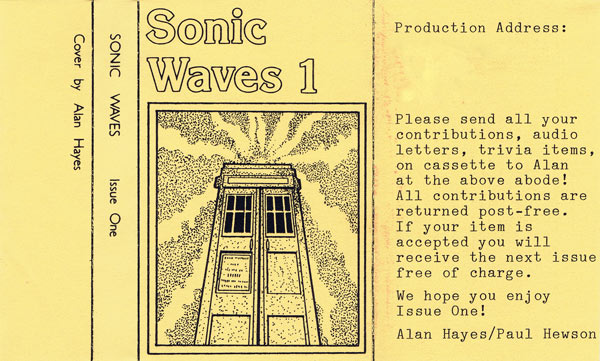
Side A:
-
Introduction by Alan Hayes and Paul Hewson
-
Diminishing Returns by Robert Franks
-
On Target? by Alan Hayes
-
Dramatic Reading: 23-11-1963 by Paul Hewson
-
Eric Saward Overview by Darren Field
-
Review: The Invisible Enemy by Alan Hayes
-
Convention Guest Panel: Twenty Years of a Time Lord: The
Pertwee Era Forum with Jon Pertwee, Nicholas Courtney and Richard
Franklin
Side B:
-
Convention Guest Panel: Twenty Years of a Time Lord: The Pertwee Era
Forum (concluded)
-
BBC Trailer: The Web of Fear
-
Review: First Half of Season 21 by Darren Sevket
-
Monsters of the First Season by Alan Hayes
-
A Letter from the Doctor by Colin Baker
-
Letters from David Hamilton, Matthew Sweet and Richard
Clarke
-
Trivia Section – comprising (a) BBC Trailer: The Mind
of Evil, (b) The ‘Delaware’ Theme – Delia Derbyshire and Brian
Hodgson, (c) 1980 BBC Repeat Trailer: Destiny of the Daleks,
(d) Keep Australia Beautiful – 2 x Australian Commercials
-
Sonic Waves 1 Sign Off by Alan Hayes
SONIC
WAVES – ISSUE 2
March 1985, C-90
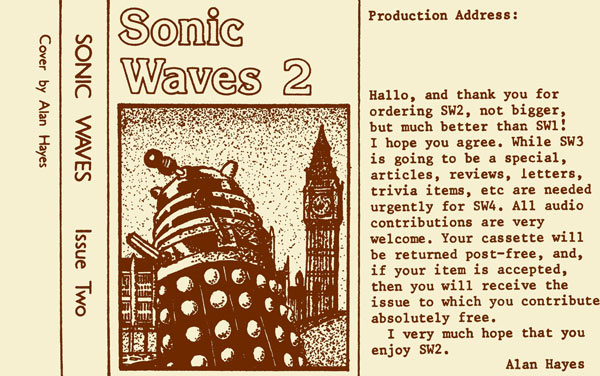
Side A:
-
Introduction (Hitchhiker’s Guide to the Galaxy
homage) by Alan Hayes
-
Ian Chesterton by Matthew Sweet
-
Just Around the Corner by Alan Hayes
-
Trivia Section – comprising (a) BBC Trailer:
Snakedance, (b) BBC Trailer: The Sun Makers, (c) BBC
Trailer: Season 17 (A Warning from the Guardian), (d) BBC Trailer:
The Creature from the Pit, (e) 1984 BBC Repeat Trailer:
The Five Doctors
-
Review: The Mind of Evil by Jim Mortimore
-
What’s Yellow and Dangerous: The News Huddlines
Side B:
-
Convention Guest Panel: Twenty Years of a Time Lord: The Davison Era
Forum with Peter Davison, Sarah Sutton, Janet Fielding, Mark
Strickson, Anthony Ainley and Valentine Dyall
-
Review: Recall UNIT by Jean Riddler
-
The Rotting Core of Fandom by Alan Hayes
-
Drama: Crisis Point by Jim Mortimore, Owen Parker
and Alan Hayes
-
Audio Review: The Space Wail (Audio Visuals 1.1)
by Alan Hayes
-
February 27th 1985 – Save Doctor Who!!! by Alan
Hayes
SONIC
WAVES – ISSUE 3:
THE SEASON 22 SPECIAL
May 1985, C-90
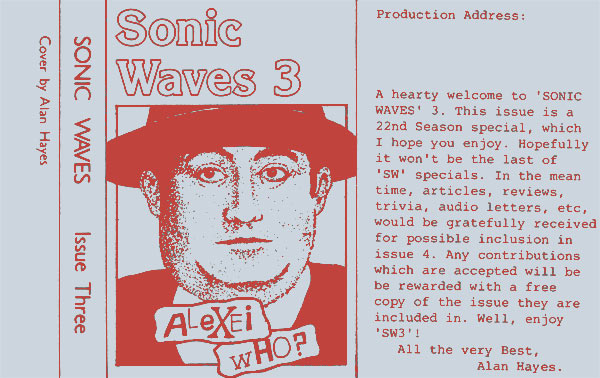
Side A:
-
Introduction (Wake Up Call / Welcome!) by Alan Hayes
-
Review: Attack of the Cybermen by Tim Ryan
-
45 Minute Episodes by Alan Hayes
-
Review: Vengeance on Varos by Steve Watts
-
A Letter from the Doctor by Colin Baker
-
Review: The Mark of the Rani by Trevor Phillippo
-
Review: A Fix with the Sontarans by Jean Riddler
Side B:
-
Review: The Two Doctors by Daniel Cohen
-
Season 22: The Monsters by Robert Cook
-
Review: Timelash by Jim Mortimore
-
Season 22: The Guest Stars by Matthew Sweet
-
Season 22: The Regulars by Robert Franks
-
Review: Revelation of the Daleks by Alan Hayes
-
Sonic Waves 3 Sign Off by Alan Hayes
SONIC
WAVES – ISSUE 4
October 1985, C-90
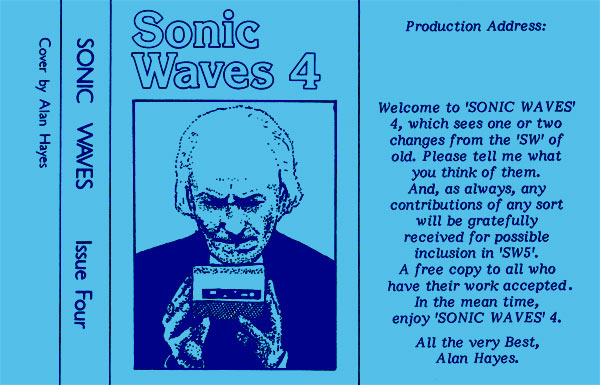
Side A:
-
Humour: Doctors in Distress by Daniel Cohen
and Adam Vanger
-
Introduction (Monty Python's Flying Circus) by
Alan Hayes
-
Audio Review: The Time Ravagers (Audio Visuals
1.2) by Jim Mortimore
-
Marvel’s Sixth Doctor by Alan Hayes
-
Commercial: Back Issues by Alan Hayes
-
Trivia Section – comprising (a) BBC Trailer: Full
Circle, (b) BBC Trailer: The Ambassadors of Death, (c)
BBC News (23.04.1975): William Hartnell’s death reported, (d)
BBC Trailer: The Invisible Enemy, (e) 1980 LBC Commercial:
The Doctor Who Experience at Madame Tussaud’s
-
A Holiday for the Doctor? by Tim Ryan
-
Review: The Daleks’ Master Plan by Robert Franks
Side B:
-
Humour: The Doctors’ Schooldays (Part 1) by Daniel Cohen,
Adam Vanger and Steve Watts
-
Unhappy Endings by Robert Cook
-
Humour: The Doctors’ Schooldays (Part 2) by Daniel
Cohen, Adam Vanger and Steve Watts
-
Interview: Nicholas Briggs by Jim Mortimore
-
Review: Slipback by Matthew Sweet
-
Humour: The Doctors’ Schooldays (Part 3) by Daniel
Cohen, Adam Vanger and Steve Watts
-
Letter from Matthew Sweet
-
A Letter from the Doctor by Colin Baker
-
Sonic Waves 4 Sign Off by Alan Hayes
SONIC
WAVES – ISSUE 5: THE LEISURE HIVE II SPECIAL
January 1986, C-90
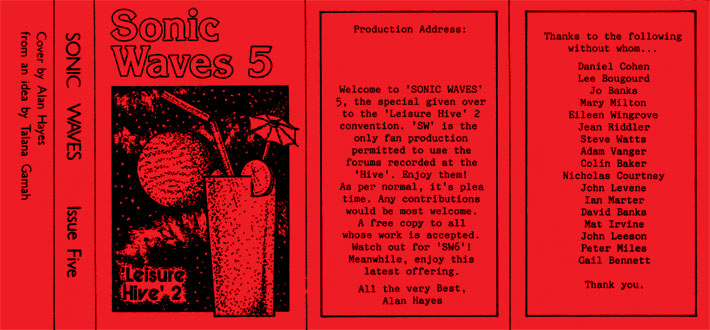
Side A:
-
Introduction by Alan Hayes and Jean Riddler
-
Leisure Hive II Guest Panel – with Nicholas Courtney,
John Levene, Ian Marter and David Banks
-
Interview: David Banks by Jean Riddler
-
The Charity by Alan Hayes
-
Leisure Hive II Guest Panel – with John Levene, Peter
Miles, Gail Bennett, Nicholas Courtney, Ian Marter, Mat Irvine and
John Leeson
-
Letters from Jason Jackson, Stephen Broome and David
Hamilton
-
Trivia Section – comprising (a) BBC Trailer: The
Androids of Tara, (b) BBC Trailers (x2): The Ribos Operation,
(c) BBC Trailer: Castrovalva
Side B:
-
Interview: The Attendees by Jean Riddler
-
The Fancy Dress Competition by Alan Hayes
-
Leisure Hive II Guest Panel – with Colin Baker
-
A Letter from the Doctor by Colin Baker
-
Humour: Density of the Daleks by Daniel Cohen,
Adam Vanger and Steve Watts
-
The Cabaret by Jean Riddler
-
Interview: The Organisers by Jean Riddler
-
Sonic Waves 5 Sign Off by Alan Hayes
-
Interview: John Leeson and Mat Irvine by Jean Riddler
SONIC
WAVES – ISSUE 6 (DOUBLE ISSUE)
September 1986, C-90 x 2
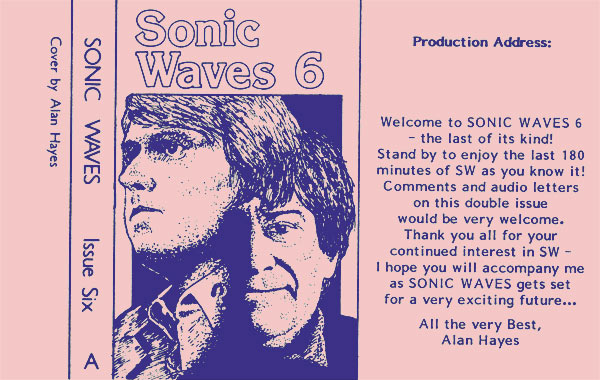
Side A:
-
Vogon Announcement by Alan Hayes with apologies to
Douglas Adams
-
Introduction by Alan Hayes
-
Volumes of Villainy by Alan Barnes
-
The Doctor Who Shop by Robert Franks
-
Trivia Section 1 – comprising (a) Tom Baker on Animal
Magic (BBC1, 1.5.1979), (b) Arabic Dubbed Daleks, (c) BBC
Trailer: The Armageddon Factor, (d) BBC Trailer: The Sun
Makers, (e) ABC Australia Trailer: Kinda
-
Review: Enlightenment by Martin Holder
-
He Can’t Stand Up for Falling Down: Kamelion by Alan
Hayes
-
Letters from Daniel Adams, ‘Jim Bostock’ (Daniel Cohen),
Jason Jackson and ‘Harold Prod’ (Robert Franks)
Side B:
-
Vogon Warning by Alan Hayes with apologies to Douglas Adams
-
Six and Violence by Tim Ryan
-
Comedy Song: Going Overboard (The Eraserman) by
Daniel Cohen, Adam Vanger and Steve Watts
-
Review: Colin Baker’s Aladdin by Jean Riddler
-
Trivia Section 2 – comprising (a) ABC Australia Trailer:
Warriors’ Gate, (b) ABC Australia Trailer: The Five
Doctors, (c) ABC Australia Trailer: Warriors of the Deep
-
Cybermen: The Untold Story... Told! by David Banks
-
Review: Blackpool, Zeta Minor by Matthew Sweet
-
Dramatic Reading: Home or Away by Jean Riddler,
with Martin Holder and a music score by Jim Mortimore
-
Commercial: Audio Visuals by Nicholas Briggs
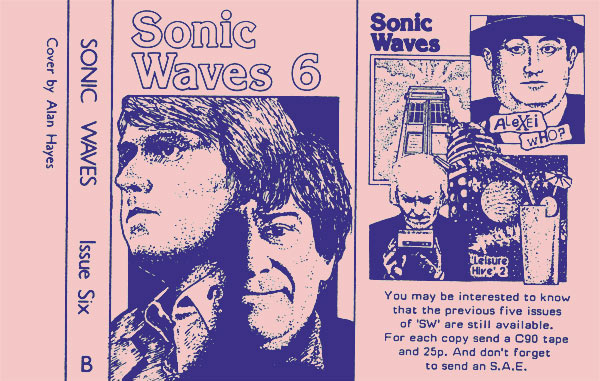
Side C:
-
Vogon Poetry by Alan Hayes with apologies to Douglas
Adams
-
It Takes Two, Baby! by Martin Holder
-
Story Synopsis and Review: The Power of the Daleks
by Alan Hayes
-
Interview: Mat Irvine by Alan Hayes
-
Trivia Section 3 – Prime Computer Adverts
-
What Bid for the Dalek? by Jean Riddler
Side D:
-
The Vogon Gets A Bit Excited by Alan Hayes with apologies to Douglas
Adams
-
The Lively Arts
- Whose Doctor Who? Review by ‘Tom Baker’ (Steve
Watts)
-
Review: Doctor Who and the Silurians by Nicholas
Briggs
-
Humour: When I Was Doctor by Daniel Cohen, Adam
Vanger and Steve Watts
-
A Letter from the Doctor by Colin Baker
-
Behind-the-Scenes: Trailing a Time Lord by Alan Hayes
-
Humour: The Doctors to the Rescue by Daniel Cohen
and Adam Vanger
SONIC
WAVES MEDIA MAGAZINE – ISSUE 1
March 1987, C-90
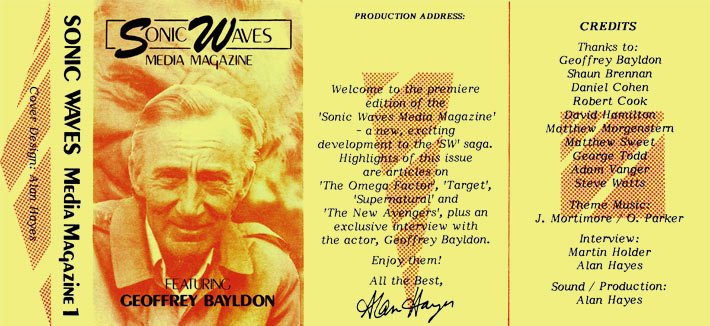
Side A:
-
Introduction by Alan Hayes
-
Review: Target (1977-78 BBC series) by ‘George
Todd’ (Matthew Morgenstern)
-
Review: Supernatural: The Club of the Damned (1977
BBC series) by Martin Holder
-
Interview: Geoffrey Bayldon by Martin Holder and Alan
Hayes
-
Review: Phoenix Five (1970 Australian children’s
science-fiction series) by Shaun Brennan
Side B:
-
Review: The Omega Factor (1979 BBC series) by Alan Hayes
-
Humour: Mission to Magma – Episode 1 by Daniel
Cohen, Adam Vanger and Steve Watts
-
The Legendary Sherlock Holmes by Matthew Sweet with
Andrew Cleven
-
Review: The New Avengers by Robert Cook
SONIC
WAVES: THE SPECIAL EDITION – ISSUE 1
September 2000, CD-R 74 x 2
(Limited Circulation - distributed for free)
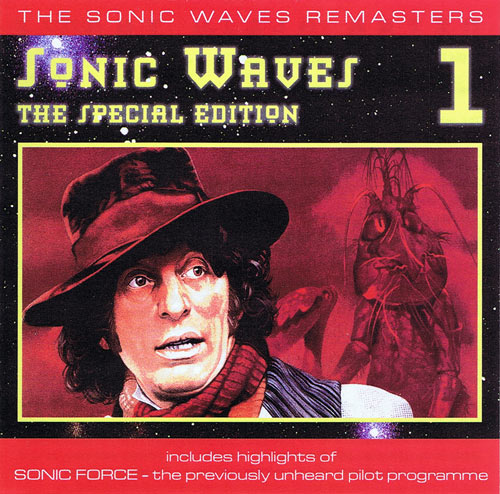
Source artwork:
Roy Knipe
Disc A:
-
Introduction by Alan Hayes and Paul Hewson
-
Diminishing Returns by Robert Franks
-
On Target? by Alan Hayes
-
Dramatic Reading: 23-11-1963 by Paul Hewson
-
Eric Saward Overview by Darren Field
-
Review: The Invisible Enemy by Alan Hayes
-
Convention Guest Panel: Twenty Years of a Time Lord: The
Pertwee Era Forum with Jon Pertwee, Nicholas Courtney and Richard
Franklin (includes material originally on Side B of the 1984
cassette)
Disc B:
-
BBC Trailer: The Web of Fear
-
Review: First Half of Season 21 by Darren Sevket
-
Monsters of the First Season by Alan Hayes
-
A Letter from the Doctor by Colin Baker
-
Letter from David Hamilton
-
Letters from Matthew Sweet
-
Letters from Richard Clarke
-
Trivia Section Introduction by Alan Hayes
-
BBC Trailer: The Mind of Evil
-
The ‘Delaware’ Theme by Delia Derbyshire and Brian
Hodgson
-
1980 BBC Repeat Trailer: Destiny of the Daleks
-
Keep Australia Beautiful (a) – Australian
Commercial
-
Keep Australia Beautiful (b) – Australian
Commercial
-
Trivia Section Summary by Alan Hayes
-
Sonic Waves 1 Sign Off by Alan Hayes
-
Sonic Waves 2000 Sonic Waves 2000 Introduction by Alan Hayes
-
Sonic Force Introduction by Alan Hayes and Paul
Hewson
-
Review: An Unearthly Child (Pilot Episode) by Alan
Hayes
-
Dramatic Reading: 23-11-1963 (Original Version) by
Paul Hewson
-
Parting Thoughts by Paul Hewson
-
On Target? (Original Version) by Alan Hayes
-
Sonic Force Outtakes by Alan Hayes and Paul Hewson
-
Sonic Waves 2000 Sign Off by Alan Hayes
SONIC
WAVES: THE SPECIAL EDITION – ISSUE 2
October 2000, CD-R 80 x 2
(Limited Circulation - distributed for free)
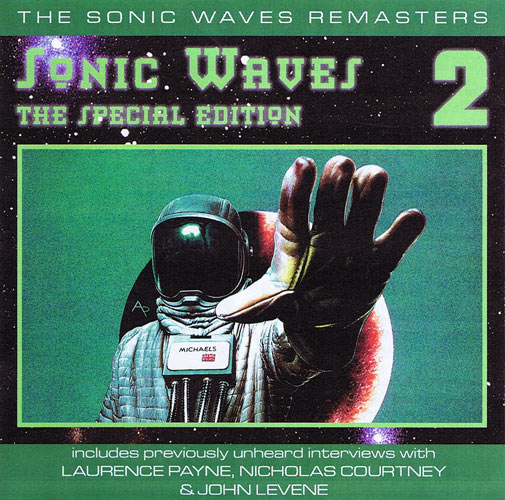
Source artwork:
Alister Peason
Disc A:
-
Introduction (Hitchhiker’s Guide to the Galaxy
homage) by Alan Hayes
-
Ian Chesterton by Matthew Sweet
-
Just Around the Corner by Alan Hayes
-
Trivia Section Introduction by Alan Hayes
-
BBC Trailer: Snakedance
-
BBC Trailer: The Sun Makers
-
BBC Trailer: Season 17 (A Warning from the Guardian)
-
BBC Trailer: The Creature from the Pit
-
1984 BBC Repeat Trailer: The Five Doctors
-
Review: The Mind of Evil by Jim Mortimore
-
What’s Yellow and Dangerous: The News Huddlines
-
Convention Guest Panel: Twenty Years of a Time Lord:
The Davison Era Forum with Peter Davison, Sarah Sutton, Janet
Fielding, Mark Strickson, Anthony Ainley and Valentine Dyall
-
Review: Recall UNIT by Jean Riddler
-
The Rotting Core of Fandom by Alan Hayes
-
Drama: Crisis Point by Jim Mortimore, Owen Parker
and Alan Hayes
-
Audio Review: The Space Wail (Audio Visuals 1.1)
by Alan Hayes
-
February 27th 1985 – Save Doctor Who!!! by Alan
Hayes
Disc B: The Sonic Waves 2000 Interview Special
-
Laurence Payne talks to Alan Hayes
(DoctorCon, University of
Essex, 20.8.1988)
-
Laurence's first convention
-
Working on Doctor Who
-
Laurence Payne - Author
-
Nicholas Courtney talks to Martin Doherty
(DoctorCon,
University of Essex, 20.8.1988)
-
Did You Ever Meet My Auntie Mabel?
-
War Time
-
Whatever Happened to the Brigadier
-
John Levene talks to Alan Hayes and Daniel Cohen
(Henley-on-Thames, 31.1.1989)
-
Monster!
-
The Who Family
-
The Convention Circuit
-
War Time
-
Myth Makers
-
The Soldier
-
Future Plans
-
Sonic Waves 2000 Sign Off
SONIC
WAVES: THE SPECIAL EDITION – ISSUE 3
November 2000, CD-R 74 x 2
(Limited Circulation - distributed for free)
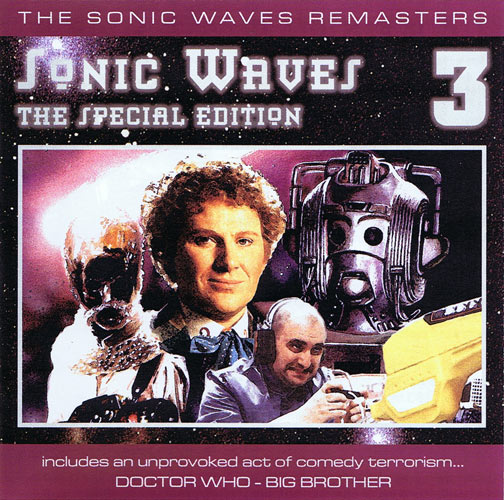
Source artwork: Colin
Howard
Disc A:
-
Introduction (Wake Up Call / Welcome!) by Alan Hayes
-
Review: Attack of the Cybermen by Tim Ryan
-
45 Minute Episodes by Alan Hayes
-
Review: Vengeance on Varos by Steve Watts
-
A Letter from the Doctor by Colin Baker
-
Review: The Mark of the Rani by Trevor Phillippo
-
Review: A Fix with the Sontarans by Jean Riddler
-
Sonic Waves 2000 Sonic Waves 2000 Introduction by Alan Hayes
-
The Complete Letter from the Doctor by Colin Baker
-
Interview: Nabil Shaban, talks to Martin Holder (Leisure
Hive IV, Swindon, 8.8.1987)
-
Sketch: Synthetic Decoy Interview by The Rejects
Disc B:
-
Review: The Two Doctors by Daniel Cohen
-
Season 22: The Monsters by Robert Cook
-
Review: Timelash by Jim Mortimore
-
Season 22: The Guest Stars by Matthew Sweet
-
Season 22: The Regulars by Robert Franks
-
Review: Revelation of the Daleks by Alan Hayes
-
Sonic Waves 3 Sign Off by Alan Hayes
-
Sonic Waves 2000 Sonic Waves 2000 Introduction by Alan Hayes
-
Sketch: Doctor Who – Big Brother by The Rejects
-
Outtakes from Doctor Who – Big Brother by The
Rejects
SONIC
WAVES: THE SPECIAL EDITION – ISSUE 4
March 2001, CD-R 80 x 2
(Limited Circulation - distributed for free)
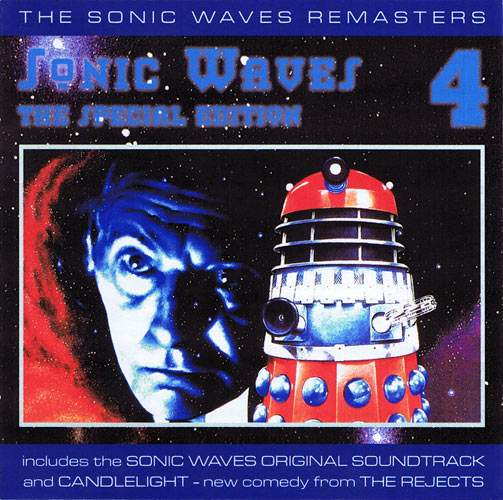
Source artwork:
Alister Peason
Disc A:
-
Humour: Doctors in Distress by Daniel Cohen
and Adam Vanger
-
Introduction (Monty Python's Flying Circus) by
Alan Hayes
-
Audio Review: The Time Ravagers (Audio Visuals
1.2) by Jim Mortimore
-
Marvel’s Sixth Doctor by Alan Hayes
-
Commercial: Back Issues by Alan Hayes
-
Trivia Section – comprising (a) BBC Trailer: Full
Circle, (b) BBC Trailer: The Ambassadors of Death, (c)
BBC News (23.04.1975): William Hartnell’s death reported, (d)
BBC Trailer: The Invisible Enemy, (e) 1980 LBC Commercial:
The Doctor Who Experience at Madame Tussaud’s
-
A Holiday for the Doctor? by Tim Ryan
-
Review: The Daleks’ Master Plan by Robert Franks
-
The Sonic Waves Original Soundtrack Sonic Waves 2001 Introduction by Alan Hayes
-
Sonic Waves Theme by Jim Mortimore
-
Better Than Pollitix by Jim Mortimore
-
Sonic Waves Theme (The BPM Remix) by Jim Mortimore
-
747 by Jim Mortimore
-
Titan Base (Link Music) by Jim Mortimore
-
Beneath the Red Sun (Voxless) by The Strange
Corporation
-
Home or Away (Original Score) by Jim Mortimore
-
Sonic Waves Mediatheme by Jim Mortimore and Owen
Parker
-
Sense Sphere by Jim Mortimore and Darren Lawbruary
-
Sonic Waves Mediatheme (Extended) by Jim Mortimore
and Owen Parker (music)
Disc B:
-
Humour: The Doctors’ Schooldays (Part 1) by Daniel Cohen,
Adam Vanger and Steve Watts
-
Unhappy Endings by Robert Cook
-
Humour: The Doctors’ Schooldays (Part 2) by Daniel
Cohen, Adam Vanger and Steve Watts
-
Interview: Nicholas Briggs by Jim Mortimore
-
Review: Slipback by Matthew Sweet
-
Humour: The Doctors’ Schooldays (Part 3) by Daniel
Cohen, Adam Vanger and Steve Watts
-
A Letter from Matthew Sweet
-
A Letter from the Doctor by Colin Baker
-
Sonic Waves 4 Sign Off by Alan Hayes
-
Sonic Waves 2001 Sonic Waves 2001 Introduction by Alan Hayes
-
The Complete Letter from the Doctor by Colin Baker
-
Sonic Waves 2001 by Alan Hayes
-
Sketch: Doctor Who – Candlelight by The Rejects
SONIC
WAVES: THE SPECIAL EDITION – ISSUE 5
December 2000, CD-R 80 x 2
(Limited Circulation - distributed for free)
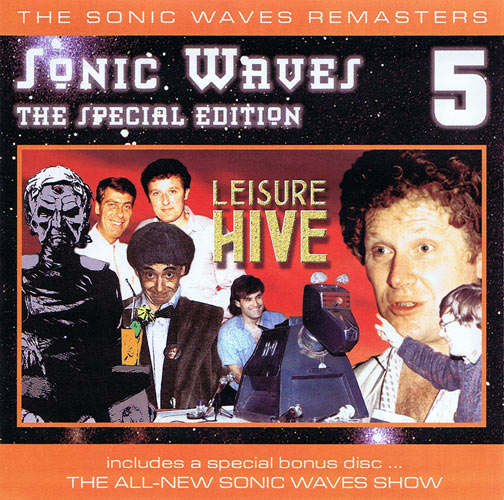
Disc A:
-
Introduction by Alan Hayes and Jean Riddler
-
Leisure Hive II Guest Panel – with Nicholas Courtney,
John Levene, Ian Marter and David Banks
-
Interview: David Banks by Jean Riddler
-
The Charity by Alan Hayes
-
Leisure Hive II Guest Panel – with John Levene, Peter
Miles, Gail Bennett, Nicholas Courtney, Ian Marter, Mat Irvine and
John Leeson
-
Letters from Jason Jackson, Stephen Broome and David
Hamilton
-
Trivia Section – comprising (a) BBC Trailer: The
Androids of Tara, (b) BBC Trailers (x2): The Ribos Operation,
(c) BBC Trailer: Castrovalva
-
Interview: The Attendees by Jean Riddler
-
The Fancy Dress Competition by Alan Hayes
-
Leisure Hive II Guest Panel – with Colin Baker
-
A Letter from the Doctor by Colin Baker
-
Humour: Density of the Daleks by Daniel Cohen,
Adam Vanger and Steve Watts
-
The Cabaret by Jean Riddler
-
Interview: The Organisers by Jean Riddler
-
Sonic Waves 5 Sign Off by Alan Hayes
-
Interview: John Leeson and Mat Irvine by Jean Riddler
Disc B: The All-New Sonic Waves Show
-
The
All-New Introduction, Little Feller by Alan Hayes
-
The Complete Letter from the Doctor by Colin Baker
-
Interview: David Banks (Alternate Edit) by Jean Riddler
-
Sketch: Where Are You From Exactly? by The Rejects
-
Latham’s Light Programme (Edited Highlights) –
Transmitted on 26.8.1989 from the Honeycomb Convention by BBC
Wiltshire Sound, and featuring Nicholas Courtney, Jon Pertwee,
Daniel Cohen, Peter Miles, Sylvester McCoy, Andy Grant and Colin
Baker. Presented by David Latham.
-
Sketch: A Clockwork Arsenal by The Rejects
-
The All-New Sonic Waves Show Sign Off by Alan Hayes
SONIC
WAVES: THE SPECIAL EDITION – ISSUE 6
December 2000, CD-R 80 x 4
(Limited Circulation - distributed for free)
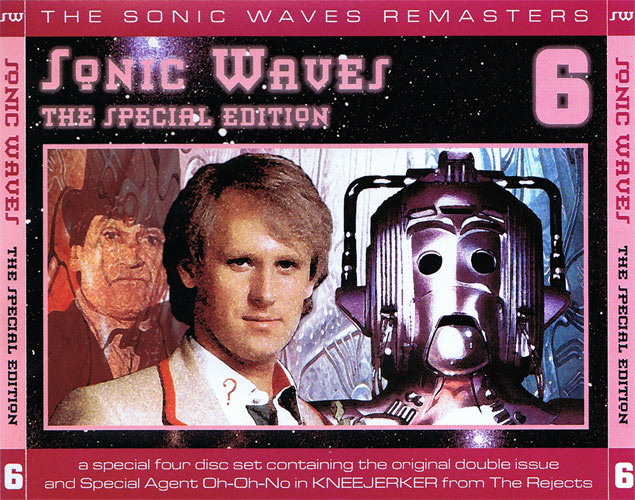
Source artwork:
Andrew Skilleter
Disc A:
-
Vogon Announcement and Introduction by Alan Hayes
with apologies to Douglas Adams
-
Volumes of Villainy by Alan Barnes
-
The Doctor Who Shop by Robert Franks
-
Trivia Section 1 – comprising (a) Tom Baker on Animal
Magic (BBC1, 1.5.1979), (b) Arabic Dubbed Daleks, (c) BBC
Trailer: The Armageddon Factor, (d) BBC Trailer: The Sun
Makers, (e) ABC Australia Trailer: Kinda
-
Review: Enlightenment by Martin Holder
-
He Can’t Stand Up for Falling Down: Kamelion by Alan
Hayes
-
Letters from Daniel Adams, ‘Jim Bostock’ (Daniel Cohen),
Jason Jackson and ‘Harold Prod’ (Robert Franks)
-
Vogon Warning by Alan Hayes with apologies to Douglas
Adams
-
Six and Violence by Tim Ryan
-
Comedy Song: Going Overboard (The Eraserman) by
Daniel Cohen, Adam Vanger and Steve Watts
-
Review: Colin Baker’s Aladdin by Jean Riddler
-
Trivia Section 2 – comprising (a) ABC Australia Trailer:
Warriors’ Gate, (b) ABC Australia Trailer: The Five
Doctors, (c) ABC Australia Trailer: Warriors of the Deep
-
Cybermen: The Untold Story... Told! by David Banks
-
Review: Blackpool, Zeta Minor by Matthew Sweet
-
Dramatic Reading: Home or Away by Jean Riddler,
with Martin Holder and a music score by Jim Mortimore
-
Commercial: Audio Visuals by Nicholas Briggs
Disc B:
-
Vogon Poetry by Alan Hayes with apologies to Douglas
Adams
-
It Takes Two, Baby! by Martin Holder
-
Story Synopsis and Review: The Power of the Daleks
by Alan Hayes
-
Interview: Mat Irvine by Alan Hayes
-
Trivia Section 3 – Prime Computer Adverts
-
What Bid for the Dalek? by Jean Riddler
-
The Vogon Gets A Bit Excited by Alan Hayes with apologies
to Douglas Adams
-
The Lively Arts Review by ‘Tom Baker’ (Steve
Watts)
-
Review: Doctor Who and the Silurians by Nicholas
Briggs
-
Humour: When I Was Doctor by Daniel Cohen, Adam
Vanger and Steve Watts
-
A Letter from the Doctor by Colin Baker
-
Behind-the-Scenes: Trailing a Time Lord by Alan Hayes
-
Humour: The Doctors to the Rescue by Daniel Cohen
and Adam Vanger
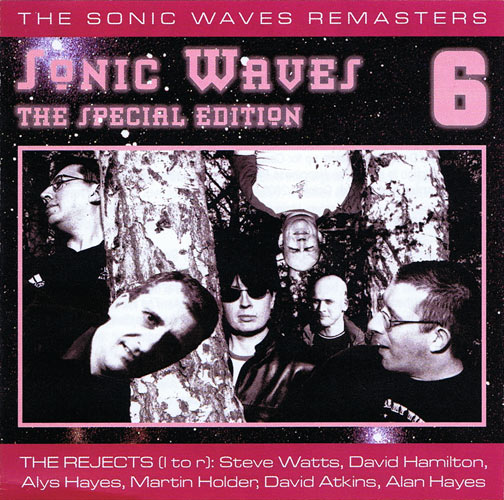
Disc C: The Rejects Present...
-
Sketch: Doctor Who – Kneejerker by The Rejects
-
The Rejects in Conversation by David Atkins, David
Hamilton, Alan Hayes, Alys Hayes, Martin Holder and Steve Watts
-
A Right Bunch of Rejects (Outtakes) by The Rejects
Disc D: Sonic Waves Six - Aftlerlife
-
The Complete Mat Irvine Audio Message by Mat Irvine
-
SW6: How Was It For You? by Alys Hayes
-
Trivia Section 4 - The Revenge (Part 1): I Am the
Doctor (Who Are You) by Blitzkrieg (1998)
-
The Complete Letter from the Doctor by Colin Baker
-
Trivia Section 4 - The Revenge (Part 2): Doctor Who
by Astralasia (1998)
-
The Complete David Banks Audio Message by David Banks
-
Trivia Section 4 - The Revenge (Part 3): Doctor Who
by Derrick Harriott and the Crystallites (1970)
-
Conversation Impossible: Villains by Martin Holder, Steve
Watts, Alys Hayes and Alan Hayes
-
Trivia Section 4 - The Revenge (Part 4): Yesterday
by Jon Pertwee and Friends (1984)
-
Douglas Adams Tribute: So Long and Thanks for All the
Frogstar Fighters by Alan Hayes
SONIC
WAVES: THE OFFICIAL DIGITAL EDITION
February 2012, MP3 Data DVD-R
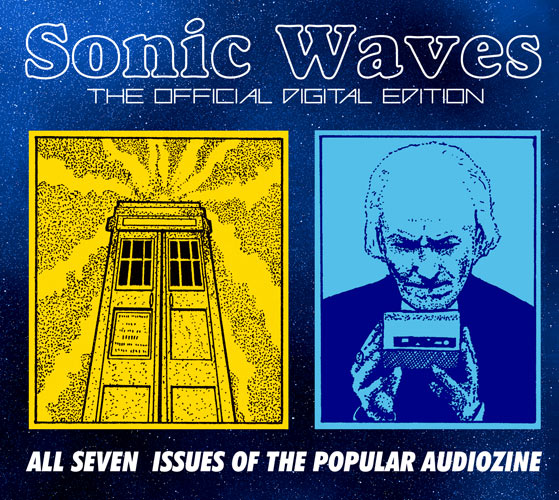
This remastered edition contained all seven original issues of
Sonic Waves plus the following bonus content:
-
Issue 1
Interview: Nicholas Courtney talks to Martin Doherty (DoctorCon,
University of Essex, 20.8.1988)
-
Issue 2
Interview: John Levene talks to Alan Hayes and Daniel Cohen
(Henley-on-Thames, 31.1.1989)
-
Issue 3
Interview: Laurence Payne talks to Alan Hayes (DoctorCon, University
of Essex, 20.8.1988)
-
Issue 4
Interview: Nabil Shaban talks to Martin Holder (Leisure Hive IV,
Swindon, 8.8.1987)
-
Issue 5
The Sonic Waves Original Soundtrack, comprising:
(a) Sonic Waves Theme by Jim Mortimore and Owen Parker
(b) Better Than Pollitix (Excerpt) by Jim Mortimore
(c) Sonic Waves Theme (The BPM Remix) by Jim Mortimore
(d) 747 by Jim Mortimore
(e) Titan Base (Link Music) by Jim Mortimore
(f) Beneath the Red Sun (Voxless) by The Strange Corporation
(g) Home or Away (Complete Score) by Jim Mortimore
(h) Sonic Waves Mediatheme by Jim Mortimore and Owen Parker
(i) Sense Sphere (Link Music) by Jim Mortimore and Darren
Lawbruary
(j) Sonic Waves Mediatheme (Extended Version) by Jim
Mortimore and Owen Parker
-
Issue 6
Sonic Waves PDFs, comprising:
(a) Sonic Waves Advertisements from Celestial Toyroom by Alan
Hayes
(b) Sonic Waves Cassette Covers by Alan Hayes
(c) Sonic Waves History by Alan Hayes
(d) Sonic Waves Contents Breakdown by Alan Hayes
(e) Commercial: Also Available from Hidden Tiger Books
|
|



